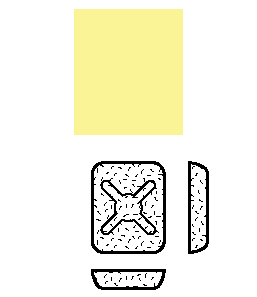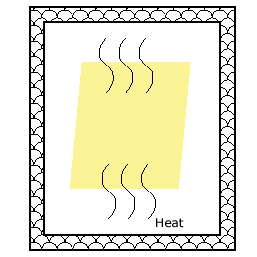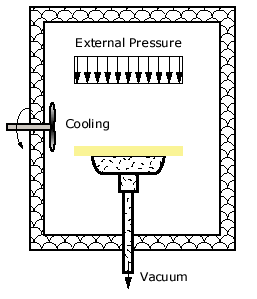Introduction to Thermoforming
A plastic thermoforming process usually begins with a sheet of thermoplastic material formed by the extrusion process using a slotted die. Thin-gage materials (less than 1/16 inch thick) usually come in rolls; and heavy-gage materials (up to 1/2 inch thick) normally come in sheets.
The sheet of plastic material is first heated to become a flexible membrane. This soft, rubber-like membrane is placed on the mold and stretched to cover the entire surface. Vacuum, external air pressure, and mechanical forces are used to rid the air bubbles and improve the surface quality. The plastic part remains in the mold until it solidifies. Excess material is trimmed after the part is removed from the mold.
Hollow or double-walled parts can be created by twin-sheet thermoforming that fuses two separate sheets simultaneously formed in their respective molds.
 |
1.The plastic sheets used in thermoforming is usually made by extrusion. The one-sided mold is usually made by aluminum. |
 |
2.This sheet of plastic material is first heated to become a flexible membrane. It is soft but still not liquid or gooey. |
 |
3.The soft, rubber-like membrane is placed on the mold and stretched to fit. Vacuum, external air pressure, and mechanical forces are used to rid the air bubbles. |
 |
4.The plastic part is removed from the mold after it cools and hardens. |
 |
5.Trimming, drilling, and other finishing processes may be needed to obtain the final product |
Aluminum is the most common thermoforming mold material due to its very high coefficient of thermal conductivity that allows speedy and consistent cooling cycle.
Most thermoplastic materials can be used for thermoforming:
Acrylonitrile Butadiene Styrene (ABS)
Acrylic
Polycarbonate (PC)
Polyethylene (PE)
Polypropylene (PP)
Polystyrene (PS)
Polyvinylchloride (PVC)
Some Considerations of Thermoforming
The forming time and temperature must be carefully controlled from run to run. Any changes in time and temperature cycles may affect the dimensional consistency and shrinkage rate.
The plastic's coefficient of thermal expansion can not be neglected especially for parts over 40 inches in size. It is good practice to add a note to the drawing specifying a temperature at which the dimensions should be measured.
Make sure the set temperature of the resin has been reached before releasing the part from the mold.
Pros and Cons of Thermoforming
Pros
Low initial setup costs
Fast setup time
Low production costs
Less thermal stresses than injection molding and compression molding
More details and better cosmetics than rotational-molded products
Cons
Geometries limited to thin shells or shallow shapes
One side of the product can be precisely controlled by the mold dimensions while the other side can not.

